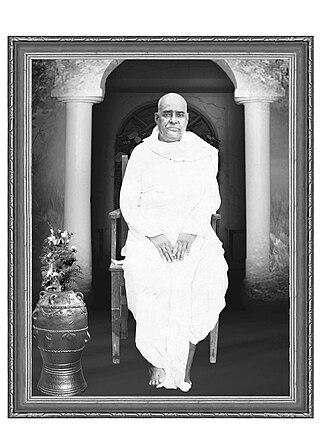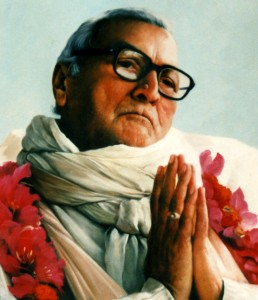
Odia is an Indo-Aryan language spoken in the Indian state of Odisha. It is the official language in Odisha, where native speakers make up 82% of the population, and it is also spoken in parts of West Bengal, Jharkhand, Andhra Pradesh and Chhattisgarh. Odia is one of the many official languages of India; it is the official language of Odisha and the second official language of Jharkhand. The language is also spoken by 700,000 people in Chhattisgarh.

Paramahamsa, also spelled paramahansa or paramhansa, is a Sanskrit religio-theological title of honour applied to Hindu spiritual teachers who have become enlightened. The title literally means "supreme swan". The swan is equally at home on land and on water; similarly, the true sage is equally at home in the realms of matter and of spirit. To be in divine ecstasy and simultaneously to be actively wakeful is the paramahamsa state; the 'royal swan' of the soul floats in the cosmic ocean, beholding both its body and the ocean as manifestations of the same Spirit. The word 'Paramahamsa' signifies one who is Awakened in all realms. Paramahamsa is the highest level of spiritual development in which a union with ultimate reality has been attained by a sannyasi.

Hariharananda Giri, was an Indian yogi and guru who taught in India as well as in western countries. He was born Rabindranath Bhattacharya in Nadia district, West Bengal. He was the head of the Kriya Yoga Institute, United States, and founder worldwide Kriya Yoga Centers. According to some sources, Hariharananda was a direct disciple of Yukteswar Giri.
Odia literature is literature written in the Odia language, mostly from the Indian state of Odisha. The modern Odia language is mostly formed from Tadbhava words with significant Sanskrit (Tatsama) influences, along with loanwords from Desaja, English, Hindustani (Hindi/Urdu), Persian, and Arabic. Its earliest written texts date from around 1000 CE. The earliest Odia newspaper was Utkala Deepika, first published on August 4, 1866.

Kabi SamrataUpendra Bhanja was a 17th-century Odia poet-composer of classical Odissi music. He is most known for his Odissi songs and kabyas written in the Odia language, primarily Baidehisa Bilasa, Labanyabati & Koti Brahmanda Sundari.

Swami Nigamananda Paramahansa was an Indian yogi, guru and mystic well known in Eastern India. He is associated with the Shakta tradition and viewed as a perfect spiritual master of vedanta, tantra, yoga and prema or bhakti. His followers idealized him as their worshipped and beloved thakura.

Durga Charan Mohanty (Odia:ଦୁର୍ଗାଚରଣ ମହାନ୍ତି, was an Odia Indian spiritual writer born in 1912 at Biratunga, a village under block Gop, near Konark, Odisha. The Odia Sahitya Akademi has been awarded to him in 1956–58 due to his active involvement in development of Odia language and literature Being a disciple of Swami Nigamananda, he wrote many books and translated Nigamananda's own-written Bengali books to Odia language. He was ପରିଚାଳକ of ନୀଳାଚଳ ସାରସ୍ୱତ ସଂଘ.
Nilachala Kutir is a religious residence, formerly owned by Swami Nigamanananda, located in the holy city of Puri, India on the shores of the turbulent Bay of Bengal. Nilachala Kutir is a one-storey building situated near the "Swargadwara" landmark in Puri.
Nilachala Saraswata Sangha (NSS), is a religious organization that was founded by Swami Nigamananda Paramahansa Dev exclusively for his household devotees in Odisha on 24 August 1934 at Nilachala Kutir, Puri, India.
Biratunga is one of the villages situated in the Gop tehsil of Puri district, Orissa, India. Biratunga is located approximately 3 kilometers away from its tehsil Gop town, 40.8 kilometers away from Puri city and 68 kilometers away from Bhubaneswar, the capital city of Orissa.

Debakunda or Devkund is naturally created pond located in the Mayurbhanj district of Odisha, India, and is part of the Simlipal National Park. The flowing water from an adjacent waterfall has created this pond. There is a temple called "Ambika Mandira" that was discovered by Rajkumar Prafulla Chandra Bhanja Deo, a researcher and a king during British Raj who stayed at Devkund and researched about this place. Debakunda is home to lichen species like Parmeliaceae.

Shanti Ashram, now known as "Saraswata Matha" or "Assam Bongiya Saraswata Matha" founded by Swami Nigamananda on the occasion of Akshay Tritiya at Kokilamukh on 5th Baisakh 1319 B.S. The main objective of "Shanti Ashram" to fulfill his three missions, to propagate Sanatana Dharma, spreading true education and serve everybody as god incarnate.

Prafulla Kar was an Odia musician, singer, lyricist, writer and columnist. He received Padma Shri, the fourth highest civilian award by the Government of India in 2015 for his contribution in the field of arts.

The Bhanja dynasty is a dynasty that originated in the northern and central regions of modern Odisha before the Gupta Empire became an imperial power. The dynasty, of ancient local Kshatriya lineage as documented by Hermann Kulke, succeeded the Vindhyatabi branch of the Nagas of Padmavati, who ruled from the Keonjhar district of Odisha and included Satrubhanja of the Asanpat inscription. The Bhanj later became feudatories of the Bhauma-Kara dynasty.

The Paramahansa Upanishad, is one of the 108 Upanishadic Hindu scriptures, written in Sanskrit and is one of the 31 Upanishads attached to the Atharvaveda. It is classified as one of the Sannyasa Upanishads. According to Ramanujacharya, Paramhansa is one of the forms of Lord Vishnu who imparted vedas to Lord Brahma in the form of Divine Swan as per Vishnu-Sahasranama.
Gouri Kumar Brahma was an academician, literary critic, orator and writer. His works are mainly in Odia and Sanskrit. He was popular for his talks on Jagannath culture and literature of Upendra Bhanja in Odia, English Sanskrit and Hindi. He died at Bhubaneswar.

Bhakti Rakshak Sridhar was an Indian guru, writer, sannyasi and spiritual leader in the Gaudiya Vaishnava tradition of Chaitanya Mahaprabhu, founder-president-acharya of the Sri Chaitanya Saraswat Math.

PanditRamhari Das is a leading singer, composer, musicologist and Guru of Odissi music. Known for his renditions, compositions, lecture-demonstrations and writings, Das has served as a professor and led the Odissi vocal department in prominent musical institutions of Odisha, including the Utkal Sangeet Mahavidyalaya and the Utkal University of Culture. He is the founder of Ramhari Das Odissi Gurukula at Biragobindapur, Puri. For his contributions to Odissi music, Das received the Sangeet Natak Akademi award in 2008.

Shyamamani Devi is a Odissi classical music vocalist composer. A disciple of Gurus Singhari Shyamsundar Kar and Balakrushna Dash, she is known for her popular renditions of classical Odissi music, such as Odissi, Chhanda, Champu, etc. authored by medieval Odia musician-poets such as Upendra Bhanja, Kabisurjya Baladeba Ratha, Banamali Dasa, Gopalakrusna and others. She is also known for her renditions of light music such as traditional Odia folk music ,Odia film music and adhunika songs. In 2022, she was awarded the Padma Shri for he contributions to Odissi music.















